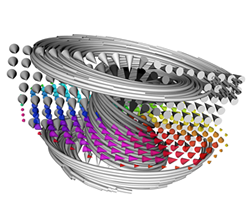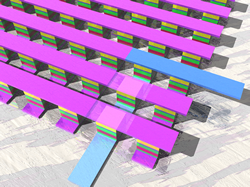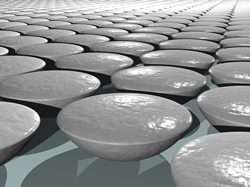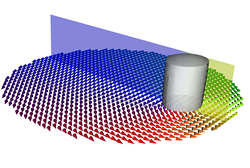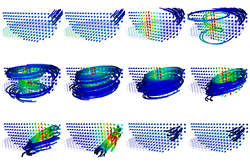| Micromagnetism | |
| What is micromagnetism? Micromagnetism is the behavioural study of ferromagnetic materials at micrometre length scales. This is an important area of research as modern storage devices are requiring denser media capable of storing large amounts of data for long periods of time.
Hard disk drives At present hard disk drives such as those found in computer workstations and servers rely on a process whereby a platter is "sputtered" with irregular magnetic grains, and many hundreds of these grains are required to reliably store even a single bit of data. This results in a capped theoretical data density for the platter in a hard disk drive of around 200 gigabits per square inch of platter - around 1.5 terabytes in a 3.5 inch disk with four layers. One of the possible solutions to this problem is to use a regular, or "patterned", medium, where equally sized and spaced tiny magnets are used; only a single one of these "nanomagnets" is required to store one bit of data, giving an areal data density of 2 terabits per square inch, allowing the production of hard disks with a capacity of 15 terabytes over four platters (see PDF). Random access memory Another application of micromagnetism is with research into magnetoresistive random access memory - MRAM. MRAM behaves in the same way to standard dynamic random access memory (DRAM) in computers, only with extra density and faster access times. The non-volatile nature of MRAM leads to persistence of state (it "remembers" its contents even when powered down) and low power consumption; a characteristic particularly attractive to manufacturers of mobile devices such as laptops and cellular telephones.
Nanoscale geometries We have investigated the suitability of nanoscale "droplets"; tiny dome-topped spheres which can be produced through chemical self-assembly processes - at diameters of 200nm they possess interesting characteristics exhibiting the combined properties of other shapes, such as the uniform rotation of magnetisation. In order to minimise their internal energy, an examination of the magnetic microstructure reveals vortex penetration, movement and exit, as shown in the images.
e-Science and micromagnetics Until recently computational micromagnetics, particularly when three-dimensional problems are considered, has been prohibitively expensive in terms of computational power. Modern high-performance workstations are capable of performing micromagnetic simulations within a few days.
Within the e-Science centre, many simulations can be performed in parallel on the 500 processor Iridis computational cluster, dramatically increasing the number of potential micromagnetic scenarios which can be simulated in a given period of time. The power provided by this facility allows dependence studies to be performed with respect to size, time and shape. Additionally, micromagnetic simulation is being used as a test case application for Grid techologies.
|
|
| People List Richard Boardman |
|
CURRENT RESEARCH |
|



